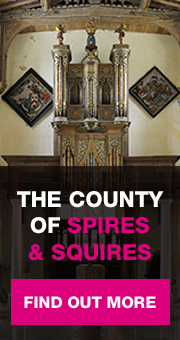On 3 April 1264. King Henry III, his son Prince Edward (later King Edward I) assembled an army and left Oxford marching towards Northampton. At their head, Henry’s dragon banner with sapphire eyes. In the meantime the rebels commanded by Simon de Montfort’s son, seized Northampton and summonsed the men of the county to gather outside the walls, near the modern day Beckets Park. Despite many protestations, they were forced to defend the towns’ south wall. The Second Baron’s War had begun! On April 4 1264 Henry III’s army began to arrive at Northampton from the south. They were prepared for a long siege and carried with them a variety of siege engines which they brought along the modern London Road and set them up to the south of the town, in what is now Beckets Park. Behind the walls, as well as the 80 or so rebel barons and their men, were all the students from Oxford and Cambridge Universities. They had all abandoned their cities after a major row with the Papal Legate two years before, and had made Northampton the main university centre of the country. At dawn 5 April 1264, the Royal Army began its assault on the south gate of Northampton. Unbeknown to the defenders, Prince Edward and Phillip Basset led a large body of men around the town to attack the north-west corner of St. Andrews Priory (most likely in the vicinity of the junction of the modern-day St. Andrews Road and Hampton Street). Whether the wall was in a poor state of repair, or it was weakened by the Prior, depends on the chronicle. It quickly collapsed. On hearing of the breach, Simon de Montfort the younger raced to its defence. Twice, the attackers were repulsed. During a third assault, Simon was thrown from his horse and was captured. The defence quickly collapsed and the Royalist infantry poured into the town. Some of the defenders ran into the churches but were quickly captured, the majority retreating into the castle. Henry’s army then began to plunder and burn the town. Although numbers are not given, many towns’ people were killed. They then prepared to lay siege to the castle itself. On the morning of 6 April 1264, the surviving rebels holding Northampton castle surrendered. Simon de Montfort the Younger was put on trial and exiled for a year. A number of the other barons were put in prison. The university scholars apparently fought hard for the rebels and Henry wanted to execute them. However, as many were the sons of his nobles, he was persuaded otherwise. Instead, Henry banned any university from being in Northampton again (although the fact Henry wanted to promote Oxford may have been the real reason). The tables would be turned a few weeks later when on 14 May 1264, the royal army was destroyed by the rebels at Lewes.
Battle of Northampton, 1264
Second Barons' War
Contact & Opening Times
Hamilton Street, Northampton
Explore the area
Click the pins on the map to see other attractions nearby
Similar places of interest
-
The Battle of Naseby fought in June 1645 was one of the seminal moments in English history. It was an overwhelming victory for Parliament, and Charles I’s principal army was eliminated...
-
Northampton’s Guildhall speaks volumes of the thriving economy and cultural aspirations of the town in the mid 19th century. The building is triumphal and richly decorated, in the...
-
Northampton was one of the principal seats of Medieval Royal Government: its castle and administrative centre for the southern part of the kingdom. This accounts for the fact that the trial...
Your login details have been used by another user or machine. Login details can only be used once at any one time so you have therefore automatically been logged out. Please contact your sites administrator if you believe this other user or machine has unauthorised access.







